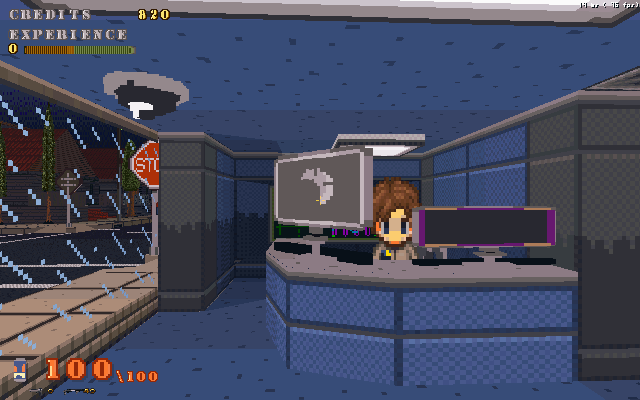Well I managed to get texture over texture
implemented into the game. Heres a split screen sample with scanline and normal views spliced together and the textures with their overlays.Prior to that I began to setup a texture library system. The system would store locations of the raw texture file as well as information on its catagory (floor/cieling, wall or overlay) and type. Now the type part matters for several things, both how the tile is compiled in the engine. For example, a texture set as metal will not only set the foot stepping noise to be for 'metal', it will also produce a flatter tile where as a 'earth' type tile will bulge in the middle more and 'mud' would sink in the middle as well as slow you down when you move.
Heres a split screen sample with scanline and normal views spliced together and the textures with their overlays.Prior to that I began to setup a texture library system. The system would store locations of the raw texture file as well as information on its catagory (floor/cieling, wall or overlay) and type. Now the type part matters for several things, both how the tile is compiled in the engine. For example, a texture set as metal will not only set the foot stepping noise to be for 'metal', it will also produce a flatter tile where as a 'earth' type tile will bulge in the middle more and 'mud' would sink in the middle as well as slow you down when you move. This clip of the texture adding part of my game's editor lists the possible types a texture can be. With the map being compiled prior to gameplay(and then precompiled in future) special qwirks of textures can create more variety in a sort of simplisitic 3d enviroment.Also needing to be -started- is models for the game. I'm not sure how I will do them yet, mostly because I want to keep them consistant with the level's shading style. Like a barrel would have its bottom vertexs set to a dark gray to create fake shading much like I've done for my floor/cieling/wall tiles.Monsters and NPCs will still be 2d, but I've yet to nail down a proper style for them, mostly from lack of time in general.
This clip of the texture adding part of my game's editor lists the possible types a texture can be. With the map being compiled prior to gameplay(and then precompiled in future) special qwirks of textures can create more variety in a sort of simplisitic 3d enviroment.Also needing to be -started- is models for the game. I'm not sure how I will do them yet, mostly because I want to keep them consistant with the level's shading style. Like a barrel would have its bottom vertexs set to a dark gray to create fake shading much like I've done for my floor/cieling/wall tiles.Monsters and NPCs will still be 2d, but I've yet to nail down a proper style for them, mostly from lack of time in general.
:O OH SHI-, no need to say more.
Very nice. The screens remind me of Thief ;)
*looks at screenshot and dies*